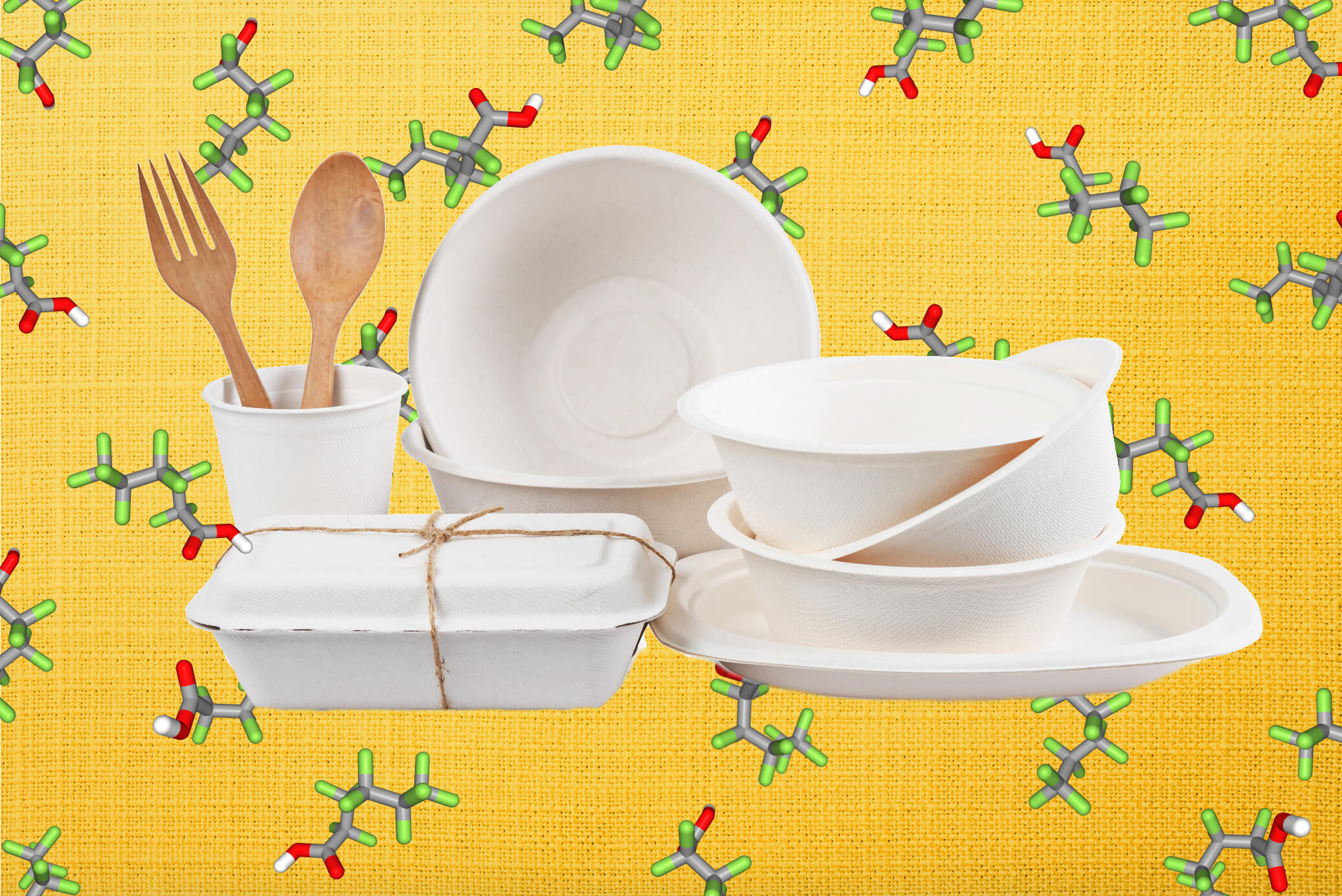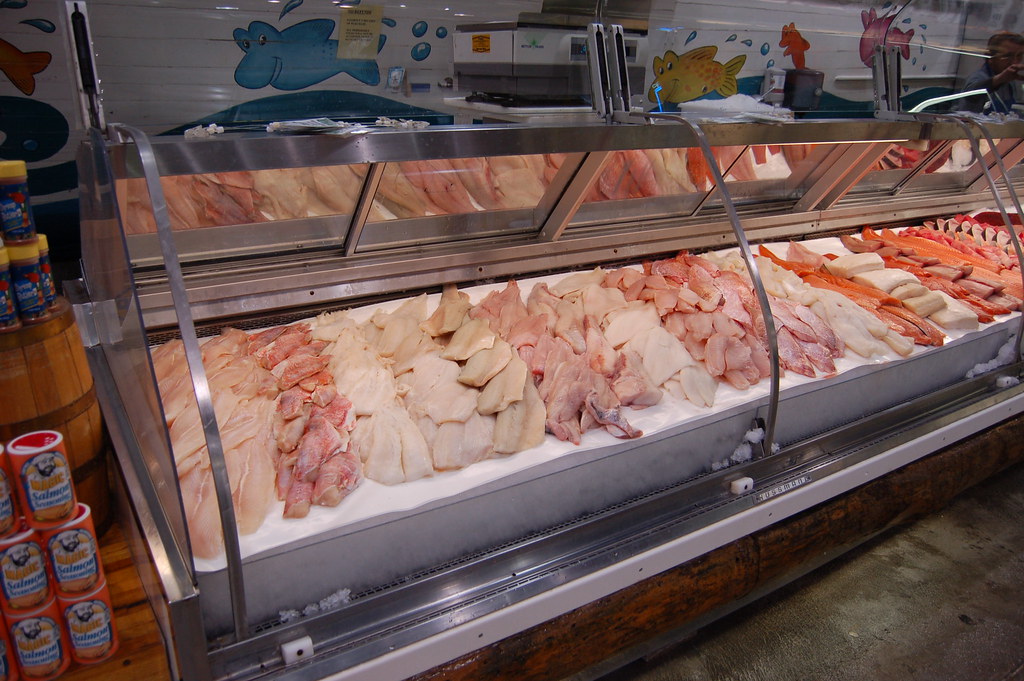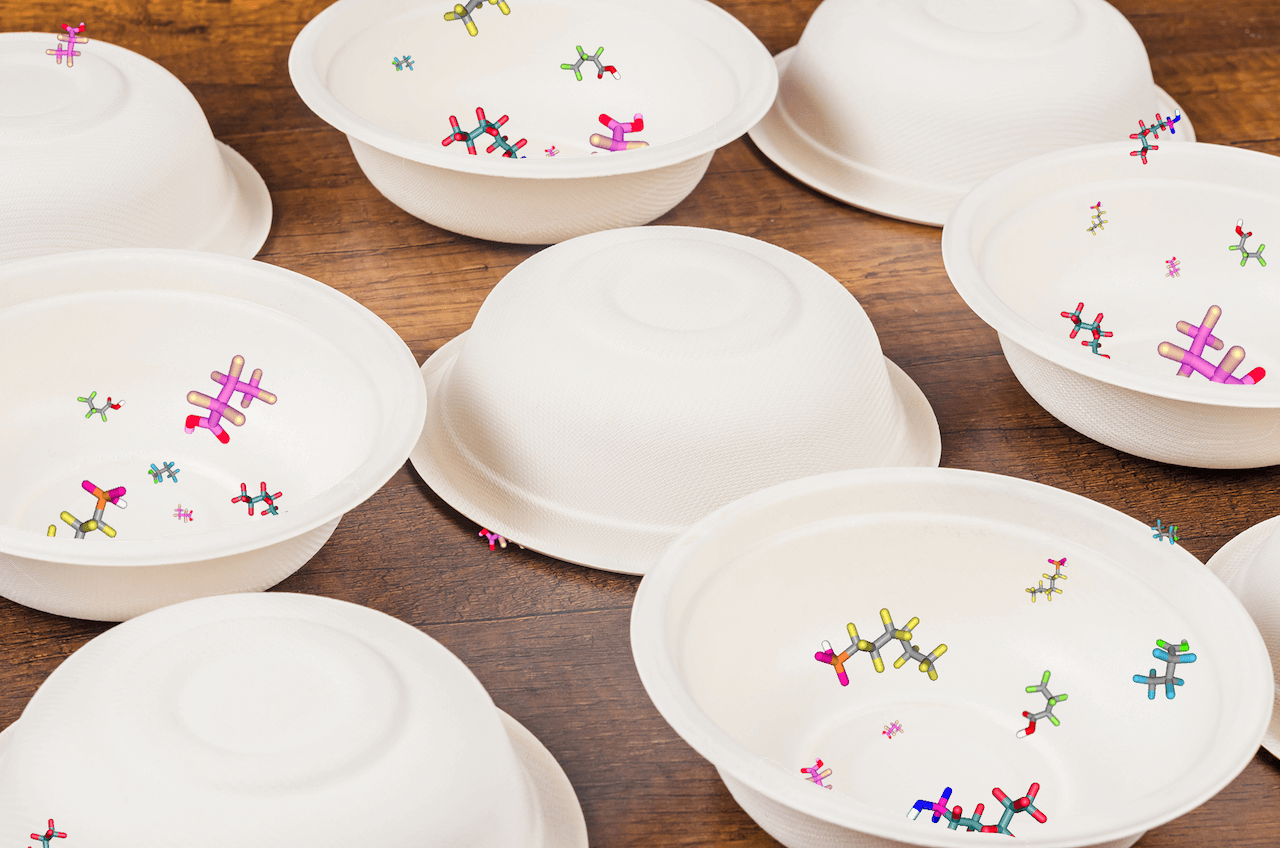
PubChem / The Counter
Testing by The Counter reveals an industry secret: All fiber bowls contain PFAS, a troubling class of chemicals with no known half-life, even when they’re certified compostable. It gets worse from there.
The biggest culinary star of the past five years isn’t a chef, or a restaurant group, or the author of a cookbook. It’s a bowl, a humble piece of take-out packaging that’s taken the world of commercial foodservice by storm, rising so quickly that few have noted its troubling secret.
When this story was first published, this publication was still called The New Food Economy. Read more about the reasons behind our name change here.
If you live in an American city and dine out with any frequency, you’ve almost certainly encountered one: a beige, earthy-looking receptacle, thicker than paper and thinner than cardboard, with a wide mouth and a base small enough to cradle in your palm. In a few short years, bowls like these—known as “molded fiber” bowls in the food-service sector—have become nothing short of a phenomenon. They’re the standard unit of measurement in fast-casual restaurants, which design whole menus around their proportions. They’re a staple for higher-end restaurateurs of the Caviar set, who use them to give take-out orders a touch of panache. And they’re ubiquitous in food halls, where often, no other form of plating is used.
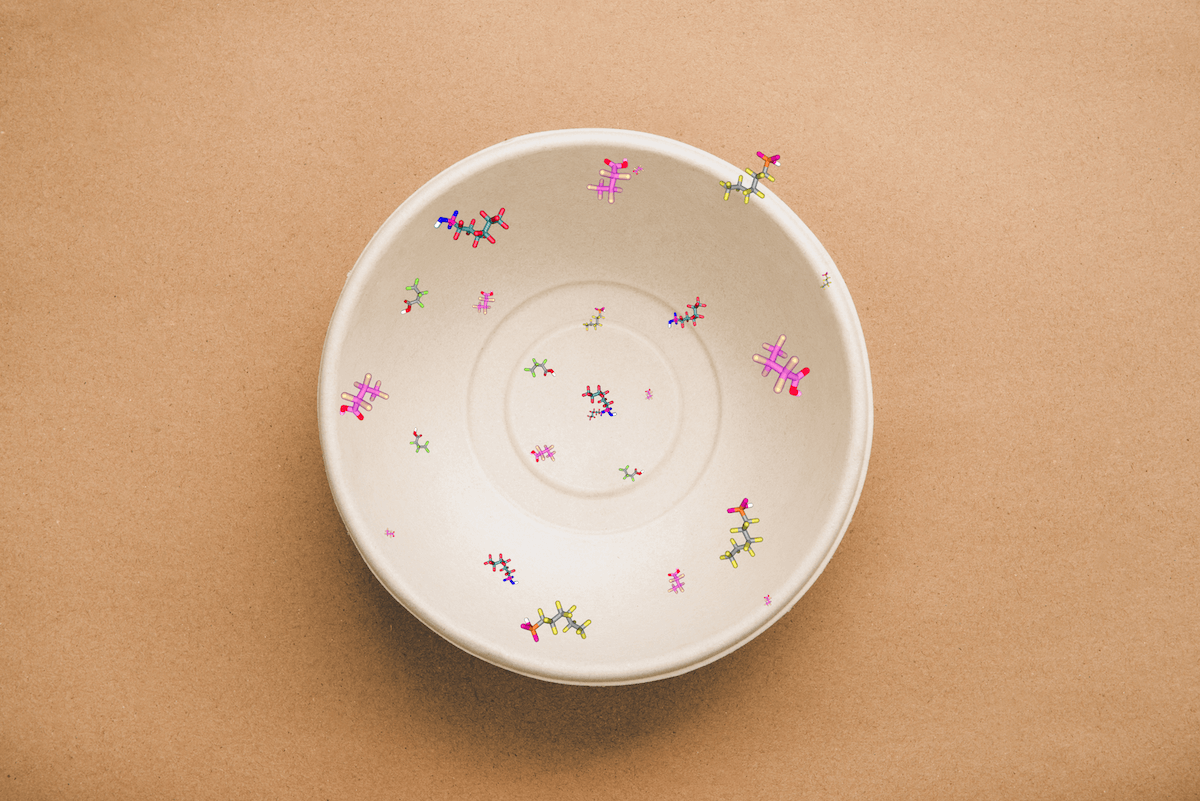
Unlike styrofoam clamshells or wax-lined soup cups, fiber products are a way to abate the guilt that comes with getting food to-go
The Counter / Pubchem / iStock
If molded fiber bowls have become a kind of status symbol in the restaurant world, conferring a fuzzy sense of corporate, social, and environmental responsibility onto the companies that use them, it’s probably because they’ve been positioned as an antidote to the industry’s alarming take-out waste problem. Many varieties are explicitly pitched to food-service buyers as compostable, certified by third-party assessors like the Biodegradable Products Institute (BPI). Unlike styrofoam clamshells or wax-lined soup cups, fiber products feel like they’d turn into mush on a leaf pile. They seem to offer convenience without the karmic debt, a way to eat that leaves no trace.
But these products, for reasons that have slipped under the radar until recently, are instead contributing to a growing environmental crisis.
According to experts consulted for this story, all molded fiber bowls contain PFAS, or per- and polyfluoroalkyl substances, a broad class of more than 4,000 fluorinated compounds that do not biodegrade naturally in the environment. This means that the bowls used at restaurants like Chipotle and Sweetgreen aren’t truly compostable, as has been claimed. Instead, they are likely making compost more toxic, adding to the chemical load of the very soil and water they were supposed to help improve. And rather than degrade quickly, they contain potentially hazardous ingredients that never break down. Not in five years, and not in 500.
In the rush, few noticed that these fiber bowls came with a hearty side of unintended consequences.
The Counter tested fiber bowls from 14 locations of 8 different New York City restaurants, including multiple outposts of Chipotle, Dig Inn (which has since changed its name to Dig), and Sweetgreen. All of the samples tested contained high levels of fluorine, which experts including Notre Dame chemist Graham Peaslee, who conducted the testing, say indicates treatment with PFAS compounds. These powerful compounds are what allow these bowls to hold hot, wet, and greasy food, which would quickly destroy any untreated paper product. PFAS is what keeps your lunch from falling into your lap.
The public health implications of this finding are not yet clear. The very worst PFAS chemicals are linked to a range of serious health outcomes, from colitis and thyroid disorders to kidney and testicular cancers, and have been mostly phased out of production in the U.S. These bowls are more likely to contain newer varieties that are just as persistent in the environment and are of grave concern to scientists, but have not been studied as closely for potential health effects.
The discovery that fiber bowls contain PFAS, which has not been reported until now, is especially surprising given that many restaurants have explicitly marketed them as compostable. Sweetgreen, for instance, uses prominent signage to inform its customers that its bowls “are plant-based, which means they go in the compost bin, along with any leftover food.” In an indicative recent tweet, Sweetgreen told a curious customer that all of its take-out containers are “100% compostable!”
all our takeout bowls, utensils, straws, and napkins are 100% compostable!
— sweetgreen (@sweetgreen) June 7, 2017
While this messaging suggests that Sweetgreen’s bowls dissipate quickly and harmlessly into the environment, the very opposite is true. PFAS are colloquially called “forever chemicals” for a reason. You might only handle your salad bowl for five minutes, but the chemicals inside it, as far as we know, will stick around for countless generations.
Fiber bowls were pitched as the take-out world’s ecological savior‚ becoming a global superstar in the process. But in the rush, few noticed that they came with a hearty side of unintended consequences. This revelation has recently thrown municipal composters, food-service manufacturers, and restaurants into a panic. And at least one U.S. city is on the verge of a logistical and public relations nightmare. On January 1, 2020, San Francisco, one of the nation’s biggest incubators of fast-casual dining, will effectively ban bowls that have been intentionally manufactured with PFAS. While that’s good news for public health, it’s also bad news for the growing number of restaurant groups who rely on the broad range of molded fiber products in their daily operations.
Manufacturers are scrambling to develop a replacement that doesn’t include PFAS by San Francisco’s deadline. As of this writing, no such alternative exists.
From pie plates to burrito bowls
Molded fiber products are nothing new. In 1903, after years of experimentation, the Keyes Fiber Company successfully used molded wood pulp to make pie plates, creating a new genre of disposable goods. Today, standard egg cartons, which are also made from mashed-up wood fiber, are commonly used in the U.S. More recently, companies have started to make molded fiber dishware from other plant materials, including bamboo and wheat straw. One leading approach is to use bagasse, the dry, pulpy material left over after juice is extracted from sugarcane. At first glance, that method appears to be a clear sustainability win. Compared to plastic and polystyrene foam, which tend to be made from virgin petroleum, bagasse-based bowls are fashioned from a renewable byproduct of the sugar-making process, material that might otherwise be wasted.
“It’s a feel-good product that makes the guest feel virtuous.”
Despite this advantage, molded fiber products long owned only a fraction of the overall take-out market. A decade ago, the foam clamshell still reigned supreme. Cheap, sturdy, heat-resistant, and impervious to grease, it was a stalwart ally of restaurants across the country. That relationship only started to shift in 2013, when New York City enacted an influential ban on single-use foam products. As dozens of other cities followed suit, many restaurateurs were forced to look for a replacement.
According to Lynn Dyer, president of the Foodservice Packaging Institute, a trade group representing take-out packaging manufacturers, foam bans led directly to the rise of molded fiber. Today, molded fiber bowls and other containers are the take-out packaging of choice for fast-casual eateries, higher-end restaurants, food halls, and other establishments that want to telegraph green values. They come in many varieties—not just 48-ounce deep bowls, 8-ounce soup bowls, and oblong burrito bowls, but clamshells, platters, plates, and cups.
“In short, it’s a feel-good product that works for the operator—less waste, halo branding, a product that makes the guest feel virtuous,” Arlene Spiegel, a New York City-based food-service consultant, told me by email.
In a few short years, molded fiber bowls became so ubiquitous and so recognizable that they’re now almost a cuisine unto themselves. In 2018, The Wall Street Journal published a piece on the rise of “bowl food,” which it defined, somewhat tautologically, as a new American tendency to “put all manner of things in bowls that once had no place there.” I’d define it somewhat differently. Today, “bowl food” tends to refer to a genre of high-concept, chef-driven, eco-friendly-esque cheap eats, one that’s growing rapidly thanks to a community of deep-pocketed investors who hope to own a piece of the next Chipotle.
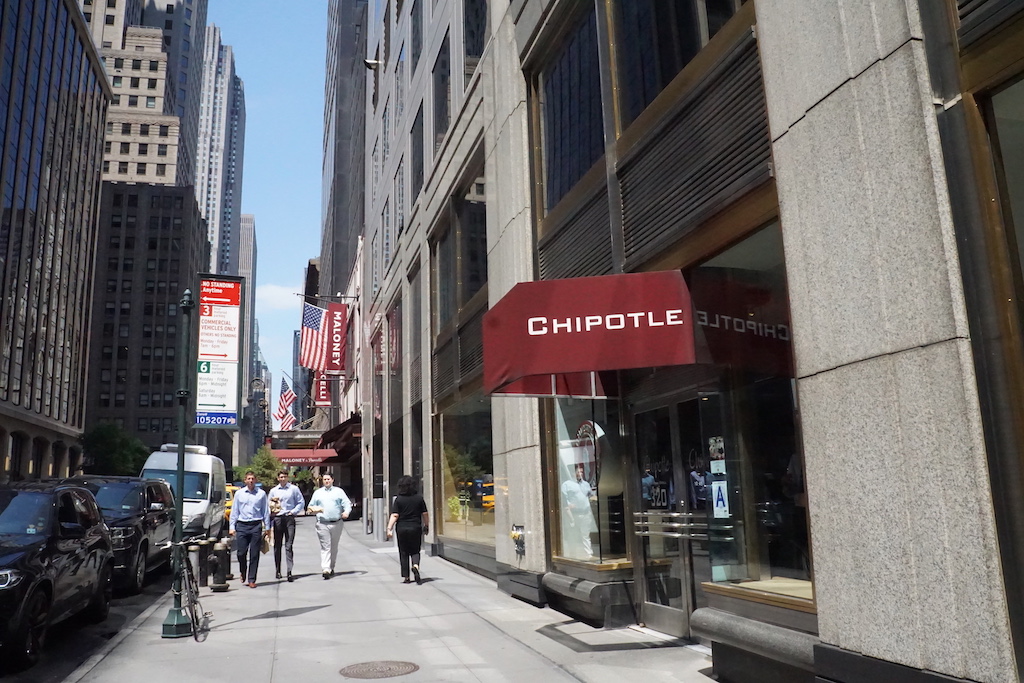
Chipotle is one of many fast-casual restaurants that uses molded fiber bowls
Jessica Fu
A key part of this appeal—the “halo branding” Spiegel refers to—is the supposed compostability of molded fiber. But the suggestion that these products biodegrade turns out to be deeply misleading (even when they do end up in appropriate composting facilities, which is by no means guaranteed). Yes, the plant fibers used to make these products often do break down under the right conditions. But these products, even when certified “100-percent compostable” by independent assessors like BPI, contain chemicals that stay in the environment forever, ruining compost, tainting soil, and polluting water in the process.
“Companies really can’t claim they didn’t use PFAS”
I started wondering if fiber bowls contain PFAS late last year, when a cohort of nonprofit advocacy groups released a report on PFAS chemicals in supermarket take-out packaging. Their study, which was first noted by Bloomberg, didn’t look at bowls. Instead, it looked at the kinds of packaging you’re more likely to encounter at salad bars and deli counters: wax paper, sandwich wrappers, and cardboard take-out boxes. Some of those products turned out to contain PFAS. One surprising detail was that Whole Foods, a retailer that routinely touts its certified compostable packaging, was the worst offender in the study, with PFAS detected in five of 17 items tested.
Whole Foods has since pledged to remove PFAS from its packaging supply chain. Still, if the company’s “compostable” take-out boxes had been treated with PFAS to make them more grease-resistant, what about the fiber bowls at restaurants like Sweetgreen and Chipotle—the kinds of places where I eat during my office lunch break? The more I thought about it, the more it seemed strange that those lightweight containers never seemed to leak grease, or fall apart while holding a dressed salad.
Trace amounts of fluorine occur everywhere. High levels prove that a product was intentionally manufactured with PFAS.
In May, I sent Graham Peaslee, the Notre Dame chemist, 19 samples to test at his at his lab. The first sample was a control: a square cut from an everyday sheet of printer paper. The other samples were unused molded fiber bowls collected from New York City eateries—including multiple locations of Chipotle, Dig, and Sweetgreen—restaurants that actively claim to compost their materials.
These bowls were gathered by New Food Economy staffers on their lunch breaks. Back at the office, I cut out a small piece from each one, a square roughly the size of the lens on a pair of sunglasses. Peaslee had made two other requests. He’d asked me to cut the curved edge of each bowl, rather than the bottom—this made it easier for him to determine which side was the food contact surface, since he wanted to test both the inside and the outside of each bowl. He also asked me to sterilize the scissors with rubbing alcohol after each cut. Fluorinated chemicals can migrate from one surface to another, and he wanted to be sure I hadn’t cross-contaminated my samples.
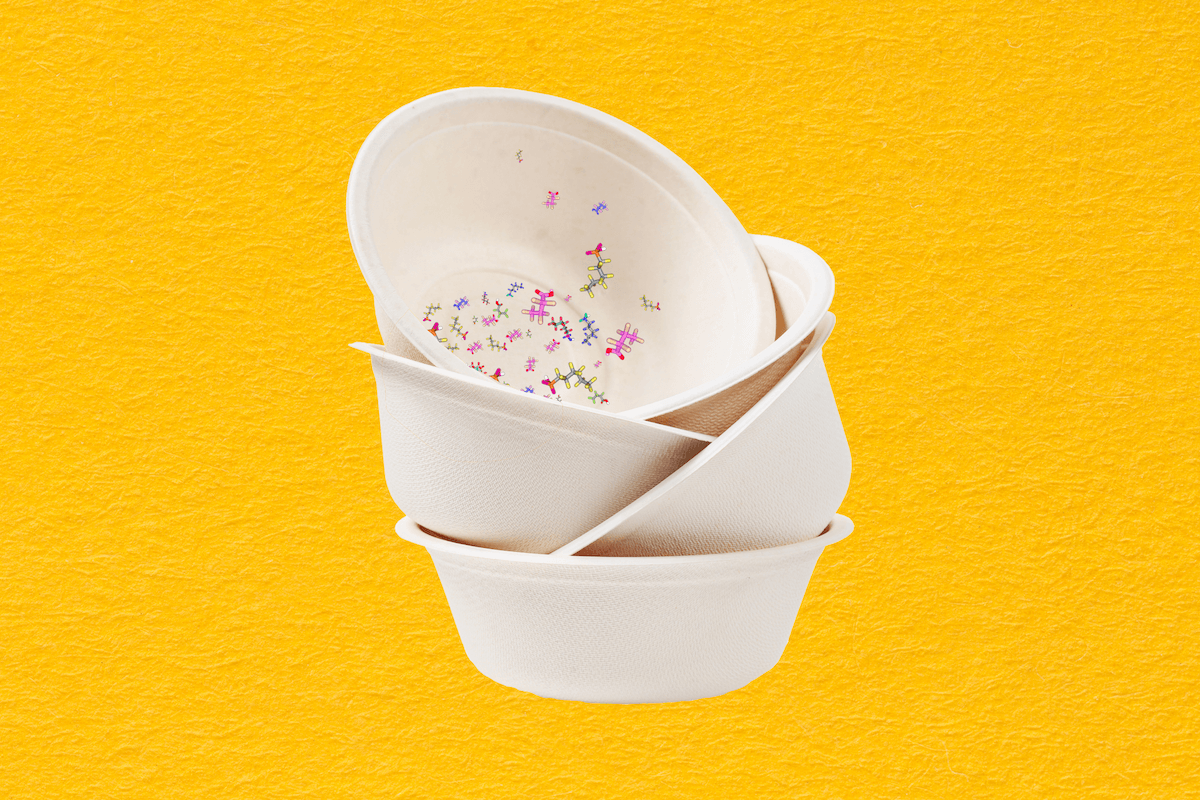
As a class, PFAS compounds tend to become problematic at very low concentrations
iStock / PubChem / The Counter
Peaslee’s test doesn’t measure PFAS per se. His lab uses a technique called Particle-Induced Gamma-ray Emission (PIGE, pronounced “piggy”), a form of ion beam analysis more typically used on rocks by geologists, to measure the total amount of fluorine in the product. Because there are thousands of PFAS chemicals in use, each one with its own unique molecular structure, it’s difficult, if not impossible, to test for every conceivable chemical. So while Peaslee’s test doesn’t show which specific compounds have been used, it’s an effective, quick, and relatively inexpensive way to determine whether a product has been treated with fluorochemicals. Though trace amounts of fluorine naturally occur in the environment, high levels prove that a product was intentionally manufactured using PFAS.
“The test Graham does is a great screening tool,” says oceanographer Rainer Lohmann, director of the University of Rhode Island’s Lohmann Lab, which studies the way that toxic, man-made chemicals including PFAS move through waterways. “If a product is showing really high fluorine levels, companies really can’t claim they didn’t use PFAS.”
A bathtub with no drain
When I received my test results back from Peaslee in June, only one sample showed low levels of fluorine: the square of printer paper. At only 33 parts per million (ppm), the level was low enough to suggest no intentional treatment. It’s possible that the paper picked up some naturally occurring organic fluorine, or was contaminated with tiny amounts of PFAS at some point on its journey to the New York City office where I work.
But the bowl samples were another story. Each one contained much higher amounts of fluorine, levels that Peaslee says can only be achieved through intentional PFAS treatment. In general, the bowls’ outsides gave a higher reading—1,740 ppm across the samples—than the food contact side of the bowls, which averaged 1,599 ppm. Together, the samples averaged 1670 ppm fluorine, or about 50 times what Peaslee found on my sample of printer paper. (A chart of the full findings can be found here.)
The highest overall reading (2,167 ppm) was found from Urbanspace Lexington, a food hall where I gathered five bowls from the different restaurants inside. (The lowest overall reading, 826 ppm, was also taken from Urbanspace.) Sweetgreen’s bowls showed slightly lower fluorine levels than Chipotle’s or Dig’s—about 200 ppm lower on average. Peaslee considers all of these samples to be “highly fluorinated,” though it’s worth noting that the levels seem to vary somewhat.
Remember that Peaslee’s test doesn’t measure PFAS, only total fluorine. That means a bowl containing 1670 ppm fluorine will contain more total PFAS, since every molecule of the chemical compound contains multiple atoms—not just of fluorine, but of carbon, and other elements. Though it’s impossible to say for sure due to the wide variety of PFAS chemicals, Peaslee tells me that, according to a rough calculation, a bowl with 1670 ppm fluorine would likely contain about 2000 ppm total PFAS. Put another way: A bowl with 2000 ppm total PFAS might be mostly made from sugarcane fiber, but 0.2 percent of its total material would be made from fluorinated chemicals.
That might not sound like very much. But due to the unique properties of fluorinated chemicals, it turns out to be a significant number, and an alarming one. The Centers for Disease Control and Prevention (CDC) maintain that drinking water can only contain infinitesimal amounts of fluorinated chemicals before health concerns arise. Not all PFAS are created equal, and the most obviously dangerous varieties have been phased out of production, meaning they’re not likely to be the kind found in the bowls we tested. Still, as a class, PFAS compounds tend to become problematic even at the very lowest concentrations.
That’s where our testing comes back into play: 2000 ppm PFAS seems minor, since it’s just 0.2 percent of each bowl. But, unlike solvents and pesticides, which have been regulated for decades at parts-per-million levels, PFAS can become a concern in drinking water at parts per trillion (ppt) levels. For example, the federal government advises that children should not drink water with concentrations of 140 ppt or higher of PFHxS, a PFAS still approved for use in some forms of food packaging. The PFAS concentrations found in the molded fiber bowls we tested were more than 10 million times that level.
To be very clear, not all PFAS are created equal. The varieties in the CDC chart above, for instance, are not likely to be those used in the bowls we tested; PFOA and PFOS are no longer allowed to be produced in or imported into the U.S. But the point is this that all PFAS are highly persistent chemicals, which stick around in the earth, and in our bodies, for a very long time.
Furthermore, any product that contains PFAS can’t really be compostable, let alone biodegradable, despite restaurants’ claims to the contrary. Though fiber products have benefits from a greenhouse gas emissions standpoint, the bowls we tested are likely making soil and water quality worse.
Rhodes Yepsen, president of BPI, the leading third-party certifier, points out that the food-service is only a small part of a larger problem. “Compostable products make up less than 1 percent of all food-service products,” he tells me, “which make up less than 1 percent of all applications that PFAS is used on.” As the Associated Press points out, PFAS are commonly used—often at even higher concentrations—in carpets, couches, outdoor gear, and even dental floss.
The bowls we tested are likely making soil and water quality worse.
But researchers who study fluorochemicals have a favorite metaphor: When it comes to PFAS, the earth is a bathtub with no drain. Because these chemicals have no known half-life, and will never go away naturally, they remain part of the earth’s ecology forever. The supply never dwindles. Every drop ever produced will slosh around eternally inside the clawfoot tub that is this planet. The fire-fighting foam, carpet, and textile industries, by far the worst PFAS offenders, account for the steadiest flow from the faucet. The world of take-out restaurants might be more of a constant trickle. Still, the bowls prized for their benign, guilt-free ephemerality are helping to fill the basin—which will remain just as full for the next generation, and the one after that, and the one 50 generations into the future, if we should be so lucky.
So, the question remains: If the earth is a tub with no drain, how much toxic bathwater can our bodies take? Because when even small amounts of PFAS chemicals go into a take-out bowl, they inevitably leach out into the environment. And from there, they inevitably make their way into us.
Long chains, short chains
Once molded fiber manufacturers have mashed raw plant-based fibers—typically processed sugarcane, but also cornstalks, sorghum, or recycled newspaper—into a pulp, PFAS is added in a process called a “wet-end” application. In other words, the fluorinated compounds are stirred into the pulpy mass, until they’re distributed somewhat evenly throughout the final product, before being pressed into shape.
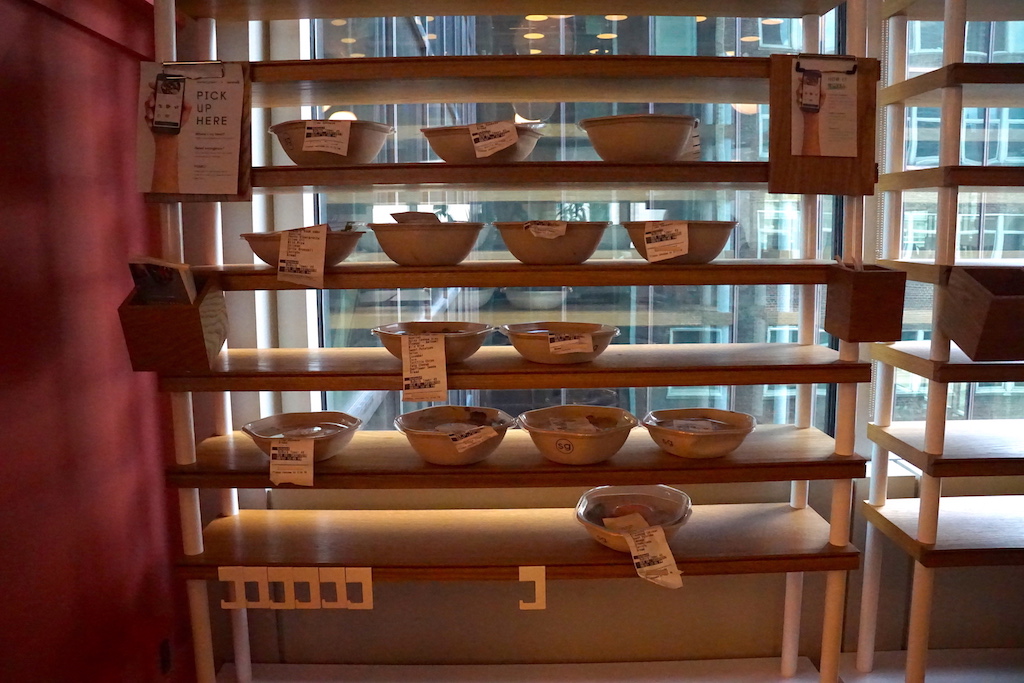
Sweetgreen salads in molded fiber bowls sit on a shelf
Jessica Fu
That’s a necessary step. Without PFAS, which has extraordinary water- and grease-repelling properties, fiber products would fall apart upon contact with hot or wet food. PFAS are great at repelling water, because they’re strong, well-defended molecules that only break down in the most extreme, man-made circumstances. I asked Lohmann, the oceanographer who runs his eponymous lab at the University of Rhode Island, to explain why these chemicals are so tenacious. He says that, while PFAS molecules can contain atoms of oxygen, hydrogen, sulfur, and/or nitrogen, their hallmark is a tight fluorine-carbon bond, a tank-like kind of molecular armor that makes them virtually indestructible.
“The carbon-fluorine bond is very, very strong,” Lohmann says. “It’s difficult to make, but once you’ve made it, it’s difficult to break apart. There’s no angle of attack anymore for enzymes, microbes, or even radiation. There’s just no natural way to break them down. We can use incinerators or other very harsh conditions to break them down, but those are technical solutions.”
Their impermeability means PFAS make a great grease barrier. But what’s the tradeoff for our health?
That’s harder to say. After all, we don’t know which specific PFAS are being used in these bowls. And restaurants themselves may not know either. Sweetgreen did not respond to repeated requests for comment. Dig was unable to provide more information by press time, though a company spokesperson expressed the desire to do so in the near future. In a phone call, representatives from Chipotle acknowledged the use of PFAS in the company’s burrito bowls, but declined to answer emailed questions about which specific compounds are present. Instead the company emailed a written statement:
“Chipotle is committed to safe and sustainable food packaging solutions and takes great care in how its packing is sourced, made and used—in addition to its end-of-life impact. Chipotle only partners with suppliers who make fluorochemical sciences and food safety a top priority. These suppliers operate under strict guidelines set forth by the FDA, and have provided Chipotle with certification that all raw material and finished pulp products fully meet the FDA regulatory guidelines for the safe use of only approved PFAS. Specifically, Chipotle does not use any of the three long-chain PFAS compounds (C8 or greater) prohibited by the FDA’s 21 code of Federal Regulations (C.F.R) Part 176. Chipotle will continue to collaborate with industry partners who invest in the research and monitoring of fluorochemical research for all packaging.”
According to Maricel Maffini, an independent researcher and former senior scientist for the Natural Resources Defense Council, there are currently 62 PFAS approved for use by FDA in food. Chipotle appears to be saying that it might be using any of the PFAS that are legally allowable in food packaging. Unsurprisingly, the company says its suppliers do not use the most dangerous PFAS compounds, known as “long-chain” PFAS, which were phased out by FDA starting in 2011. In its systematic review of available research, FDA had found that these chemicals—also known as “8C” PFAS, due to having eight carbon molecules—were linked to a variety of serious health outcomes.
Experts agree, and our testing corroborates, that virtually all molded fiber take-out packaging PFAS.
A 2017 study published in the peer-reviewed journal Environmental and Science Technology Letters, co-authored by Graham Peaslee, summarizes some of those possible adverse health effects. It’s a disturbingly long list: kidney and testicular cancer, low birth weight, thyroid disease, decreased sperm quality, pregnancy-induced hypertension, and immunotoxicity in children. Animal studies have found additional linkages, including altered mammary gland development, reproductive and developmental toxicity, obesity, and immune suppression.
“If your option is eating a cheeseburger versus a salad in a bowl that might have some PFAS, you’re probably okay with that salad.”
Of extreme concern is the “biopersistence” of PFAS chemicals, their tendency to linger for long periods inside the body. According to a fact sheet published by CDC, it can take our bodies anywhere from four to 18 years to completely excrete long-chain PFAS chemicals. Compare that to another chemical of health concern, bisphenol-a, or BPA, which only remains in the body for a few hours.
The good news is that, starting in 2000, chemical industry groups began agreeing to phaseouts of the most commonly used long-chain chemicals. Then, starting in 2016, FDA outright banned the manufacture and import of five other types long-chain PFAS. These varieties are still being made outside the U.S., which means they’re still getting into American bodies (the earth is just one bathtub). But experts I spoke to generally agreed that FDA’s decision has reduced our exposure to the most dangerous class of chemicals.
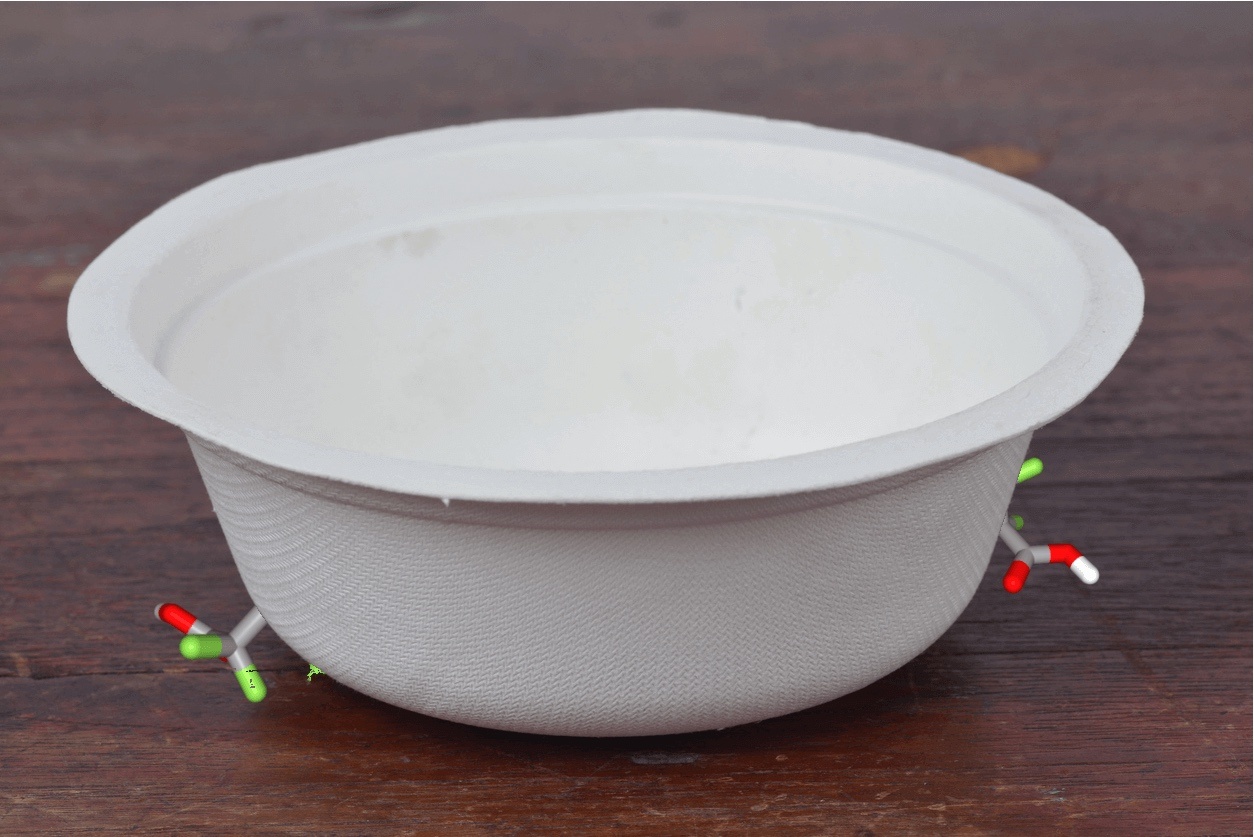
While short-chain PFAS are already widely dispersed throughout the environment and in our bodies, the longer-term sublethal effects of this dispersal simply are not known
The Counter / iStock / PubChem
They also agree, and our testing corroborates, that virtually all molded fiber take-out packaging contains PFAS—just of a different variety. Foodware today is more likely to contain “short-chain” PFAS, which consist of molecules with fewer than eight carbon atoms. Less is known about the health effects of these replacement chemicals. They simply haven’t been in use long enough to be evaluated thoroughly. A 2018 study in Environmental Sciences Europe pointed out that, while short-chain PFAS are already widely dispersed throughout the environment and in our bodies, the longer-term, sublethal effects of this dispersal are not known.
That said, short-chain PFAS—the kind most likely to be present in the bowls we tested—are still classified by the European Union’s Registration, Evaluation, Authorisation, and Restriction of Chemicals (REACH) law as chemicals of “very high concern.”
The good news is that short-chain PFAS are less biopersistent than their longer-chain counterparts. According to Laurel Schaider, a research scientist and water quality specialist at the Silent Spring Institute, an anti-pollution non-profit, the shorter-chain alternatives stay in the body for a matter of days or months, not years. That’s a crucial difference when it comes to evaluating their safety.
Unfortunately, the problems with PFAS don’t stop with direct food exposure.
Even so, a one-month half-life is still an extraordinarily lengthy interval. “If you are a pregnant woman, a month or two is a long time,” says Maffini. “And that’s just one exposure. You have to keep in mind that exposures are ongoing. It’s not one shot and you’re done.” In other words, even though short-chain fluorochemicals are less biopersistent, they’re still likely to be entering our bodies much faster than we can excrete them.
The Environmental Sciences Europe study also pointed out a number of other factors unique to short-chain PFAS, many of which are not encouraging. Short-chain varieties are just as indestructible as their longer-chain siblings. The shorter molecular structure that makes them easier to excrete also makes them harder to screen out. While water treatment facilities can use activated carbon capture to filter long-chain PFAS, this technique doesn’t work as well with the short-chain variety. They’re also more mobile, traveling with ease through waterways and through the bloodstream, which means they have the potential to disperse more widely through our individual bodies and across the globe.
Their ability to travel could also mean that you’re more likely to be eating small amounts of PFAS along with your grain bowl. According to Schaider from Silent Spring, short-chain PFAS are even more likely to migrate into food than long-chain, especially when that food is hot. Salad dressings also contain emulsifiers, she says, that have been shown to increase migration.
As the plant-based material degrades, the forever chemicals seep out—ending up in public waterways, where we drink them directly from the tap.
According to FDA guidelines, food packaging can include approved PFAS in various concentrations ranging from about 0.25 percent to 1.5 percent, depending on the chemical. At 2,000 ppm, or 0.2 percent of material, none of the bowls we tested seem to have exceeded those thresholds, though it’s hard to say that for sure without knowing more about specific chemicals. Still, remember that short-chain PFASs can stay in the body for months. I eat out of a fiber bowl nearly every day—which the Sweetgreen iPhone app makes it unnervingly easy to do, and which some sources tell me is an unwise idea.
Marty Mulvihill, co-founder of Safer Made, a venture fund that invests in eco-friendly businesses, tells me that he’s looked everywhere for a molded fiber bowl made without PFAS, to no avail. A former chemist who used to run the University of California, Berkeley Center for Green Chemistry, Mulvihill is concerned that routine daily exposures aren’t a good thing. He compares molded fiber bowls to Twinkies. They won’t kill you. But, in his view, they’re not a healthy everyday choice either.
“If it’s possible to avoid them, avoid them,” he says, speaking specifically of molded fiber bowls. “But if your option is eating a cheeseburger versus a salad in a bowl that might have some PFAS, you’re probably okay with that salad. You just don’t want to be eating it all the time, or taking them and microwaving things in it, or eating off of them on a daily basis.”
Unfortunately, the problems with PFAS don’t stop with direct food exposure. The real issue, Peaslee tells me, is the way they contaminate water. When molded fiber products end up in a landfill, they’re sequestered briefly. But as the plant-based material degrades, the forever chemicals seep out, ending up in public waterways, eventually making their way into the taps we drink from every day.
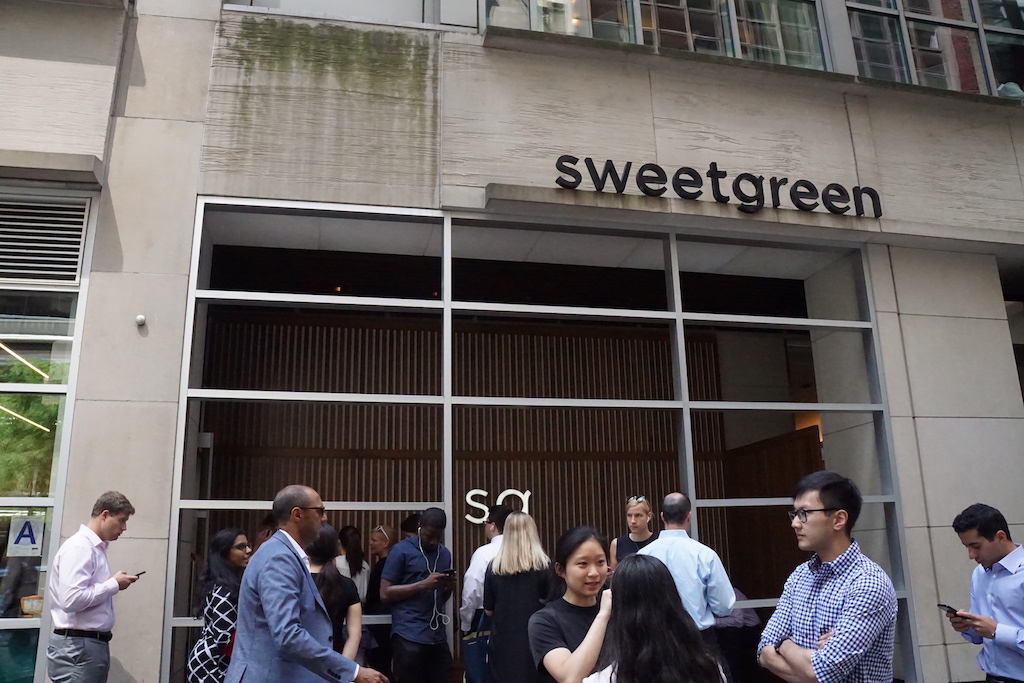
A Sweetgreen location in New York
Jessica Fu
When a product that contains PFAS decomposes in a landfill, Peaslee says, “that means 100 percent of the chemicals are coming off. Not just the one-tenth or one-hundredth of a percent that comes off in food contact, but 100 percent of it you’ll be drinking in two months. Because it goes right through the landfill treatment.” The leachate that seeps out of landfills is treated, but sincer short-chain PFAS means can’t currently be screened out, they go straight through the filtration systems into the water.
“That’s the biggest issue with PFAS in my mind,” Peaslee says. “The fact that we are now contaminating our waterways. If you don’t eat it off your wrapper, you and your kids will be drinking it out of municipal water in two months. That’s the scary part.”
Of course, some fiber bowls don’t go into the landfill at all. They’re thrown into compost facilities, where their toxicity has caught an entire industry by surprise.
“As soon as I found out, I was horrified”
In late 2015, Jen Jackson started hearing about fluorochemicals in molded fiber food packaging, and was immediately worried. A former water quality scientist who now works as the toxics reduction manager for the city of San Francisco’s Department of the Environment, she’d helped to develop the city’s pioneering composting rules, including a program that aggressively targets restaurant waste.
To try to get a handle on the problem, Jackson arranged to test the foodware being used in two city hospitals—San Francisco General and Laguna Honda, a nursing facility—both of which used compostable packaging in their cafeterias. While some of the paper and cardboard products contained PFAS, many of them were PFAS-free. But, she found, all of the molded fiber products were fluorinated. The surprising thing, in Jackson’s view, was that many of those products were certified compostable.
This meant that the bowls, dishes, and clamshells San Francisco had diverted to compost facilities were instead likely contaminating the compost—and eventually the food crops that it was used on—with PFAS.
“As soon as I found out, I was horrified,” Jackson says.
This class of products has likely been contaminating compost sites for years. Experts I spoke to said that PFAS have long been present in molded fiber dishware. There’s also some more concrete evidence. In June of this year, the first-ever study of PFAS in municipal compost facilities was published in the journal Environmental Science and Technology Letters. The study was prompted in 2018 by Heather Trim, executive director of Zero-Waste Washington, a non-profit advocacy group. When she began to hear rumors about PFAS chemicals in compostable bowls, the revelation shocked her.
Sites that accepted foodware showed PFAS levels that were about 10 times higher than the sites that didn’t.
“I did not know that these chemicals were being used extensively in products that come into contact with food,” she says.
Trim reached out to Linda Lee, a Purdue University agronomist who’d studied PFAS in biosolids, the nutrient-rich organic matter created by wastewater treatment plants when they treat domestic sewage.
“We’re really proud, in the state of Washington, that we push everything to go into the compost, so we can keep things out of landfills,” Lee remembers Trim saying. “But I think now we’ve done a bad thing.”
Trim wanted to help Lee design a study that would establish whether—and to what degree—compostable food products are adding to the toxic load of the compost created at municipal facilities. The two didn’t want to point the finger at any one operator, so they decided to look at a range of different facilities, ultimately gathering data from composting locations in Washington, Oregon, California, Massachusetts, and North Carolina. Nine of them were commercial facilities; one was a backyard compost pile. Out of the 10 locations Trim and Lee sampled from, seven sites accepted compostable foodware, while three (including the backyard pile) did not.
The results were striking. Samples from the sites that accepted foodware showed PFAS levels about 10 times higher than from the sites that didn’t. Specifically, two kinds of PFAS, PFHxA and PFBS—both shorter, 6- and 4-carbon chain compounds commonly used to increase grease and stain resistance in food packaging—were detected at much higher levels.
Lee is clear that the study doesn’t prove causation, and she can’t say for sure that the higher PFAS levels were definitely due to the presence of compostable food packaging at those sites. (The study didn’t ascertain how much compostable plateware was in each facility.) The sites that permitted dishware also contained more of the long-chain PFAS that should no longer be in use—a rise in toxicity assumedly due to substances other than food packaging, since those compounds should not be permitted in their manufacture. Still, the study suggests that the presence of compostable plateware is highly correlated to a dramatic overall rise in PFAS levels. It’s a finding that warrants further study, especially considering that research shows PFAS can easily be absorbed by fruit and vegetable crops, where compost is likely to be applied.
After her own discovery in San Francisco, Jen Jackson wanted to act quickly. The city had insisted that its restaurants use compostable dishware to make them more environmentally friendly. If there was any chance that molded fiber products were actually making compost more toxic, the city had to act.
In 2016, she called Rhodes Yepsen, who had just become president of BPI, to ask if he knew that BPI’s certified compostable molded products contained PFAS. Jackson says Yepsen had not been aware of the issue.
“No one ever thought that the manufacturing world would come up with fiber-based bowls, and put fluorinated chemicals in them.”
It’s not all that shocking that PFAS caught BPI by surprise. Like other third-party certifiers in the biodegradability space, BPI was originally founded to assess plant-based plastics, the PET bowls and clamshells that dominated the first wave of plastic replacement products. BPI had developed standards that ensured those products broke down fully into compost, not just tiny plastic pellets. It wasn’t testing for PFAS. No one in the food packaging industry was.
“No one ever thought that the manufacturing world would come up with fiber-based bowls, and put fluorinated chemicals in them,” Jackson says. “It wasn’t on BPI’s radar either.”
Jackson tells me that, in her experience, even some of the companies selling fiber bowls didn’t know they contained PFAS. Though many food-service packaging companies are headquartered in the U.S., the products themselves are often made in other countries, especially in China. But she felt it wasn’t right for those products to be marked “100 percent compostable” if they contained forever chemicals. She wanted to convince Yepsen that highly fluorinated products should no longer carry BPI’s certification.
Ultimately, Yepsen agreed that BPI should eliminate fluorinated products from those it certifies. In December of 2017, BPI announced a coming change to its standards. Beginning on January 1, 2020, it will not certify any product that contains over 100 parts per million of total fluorine. Jackson says she gives Yepsen a lot of credit for implementing the standard, which she feels is sufficient to help screen out products made with PFAS.
For now, there is no commercially viable plan B.
“We want to make sure that the products that are going to composting facilities are safe for those composting facilities and not negatively impacting their compost quality,” Yepsen says.
For context, the bowls tested by The Counter showed fluorine levels 10 to 20 times higher than the 100 ppm cutoff that BPI established. The new requirement will ensure that future molded fiber products, if they’re going to be certified by BPI, will be more like the piece of printer paper we tested: not zero total fluorine, but only enough to suggest the presence is accidental.
Untill a viable PFAS-free alternative is developed, then, San Francisco’s new rule amounts to an effective ban on molded fiber products. And while the law will take effect in a few short months, the city’s restaurants really not ready for it. Jackson’s Zero Waste Team is currently providing outreach materials to restaurants, and letting them know to expect the change. City-owned properties have already switched from molded fiber bowls and clamshells to wax-paper-lined shallow cups (“like a cup, but short,” Jackson says), as well cardboard takeout boxes lined with plant-based plastic.
Solutions do already exist, Jackson says. “There are safer alternatives out there. We can buy them. They’re on the market. They’re scalable. Distributors can accept them. So there’s no reason not to change what is allowed in San Francisco.”
But what about the businesses who have built their brands around bowls—and the message they’d hoped those receptacles would convey? For now, there is no commercially viable plan B. The food-service packaging giant Sabert, for instance, has convened an internal PFAS task force dedicated to solving the issue, but hasn’t yet announced a new alternative. Sabert declined to respond to my list of written questions, after first indicating it would. That silence may be revealing, illustrating how unprepared the food-service industry is to take this topic on. If companies like Sabert and Sweetgreen don’t even know how to talk about their fluorinated products publicly, they’re a long way from being able to provide a suitable replacement.
Doing the right thing
After the Toxic-Free Future report revealed PFAS in Whole Foods’ deli papers and hot bar boxes, Rhodes Yepsen says he sat down with company representatives to discuss BPI certification and the future of the supermarket’s products. He was asked a number of questions about BPI’s process and testing methods. But at the end of the conversation, Yepsen had a question of his own.
Why does Whole Foods, he remembers asking, care about compostable products in the first place? When commercial composting facilities are not available, as is the case in many regions throughout the country, the company doesn’t collect takeout boxes for composting. It asks people to throw them in the garbage can, where they’re taken to the landfill. But if those boxes often aren’t composted, even if they’re technically compostable, why the emphasis on BPI certification?
“They didn’t really have an answer,” Yepsen tells me.
He says he often has conversations like this one with retailers and food-service companies who want to be assured their products are compostable, even though they’re not actually composting. He’s often given vague assurances. “We just want to do the right thing,” is a sentiment he says he hears a lot.
It feels so good to believe our throwaway items will have only brief lives beyond us.
It’s important to give companies like Whole Foods credit for moving in the right direction, even if it’s incremental change, because they have really been forerunners in setting up organics diversion programs at stores across the country,” Yepsen says. “But when you’re weighing the sustainability pros and cons of choosing a product, you have to ask—well, what problem are you trying to solve?”
That’s what retailers and restaurants don’t seem to be able to answer. Does doing the “right thing” mean only reducing waste? If so, Yepsen thinks companies should work harder to start composting, or else transition to recyclable products. Not all of them want to do that. Yepsen says that some companies tell him they care, more generally, about the life cycle of their products in the environment. But if that’s the case, he asks, why aren’t they doing more to take on PFAS? Why aren’t they taking products known to contain PFAS at even higher levels—microwave popcorn, for instance—out of their stores entirely? Perhaps more broadly, Yepsen wonders why they aren’t using their clout to lobby FDA and EPA, and encouraging them to take these compounds out of the supply chain in the first place?
If companies won’t answer Yepsen directly, it could be because they sense their efforts are facile, more about optics than real-world results. And when it comes to easy virtue, the fiber bowl makes a wonderful ally. The word “compostable” is profoundly comforting in our world of obscene waste. That molded piece of sugarcane looks so earthy and delicate. Its hollow the color of something you might find in a forest, ready to turn into mulch with rain and time. If this impermanence is a fiction, it’s an intensely reassuring one.
It’s easy to sneer at the magical, self-serving logic of corporations. But as citizens, we’re not really all that different. Rather than engage in a sustained, searching way with the challenges we face, we too often place blind trust in apparent quick fixes. We want to believe our throwaway items will have only brief lives beyond us. It feels so good to let those lingering worries about the earth, and our place in it, get hauled away with the trash. This has always been the promise of bowl food. It’s also been the lie: That plant-based disposables offer a more enlightened kind of eating, a way to escape the dark connections our hunger implicates us in.
Correction: An earlier version of this story incorrectly referred to the Natural Resources Defense Council as the National Resources Defense Council.

